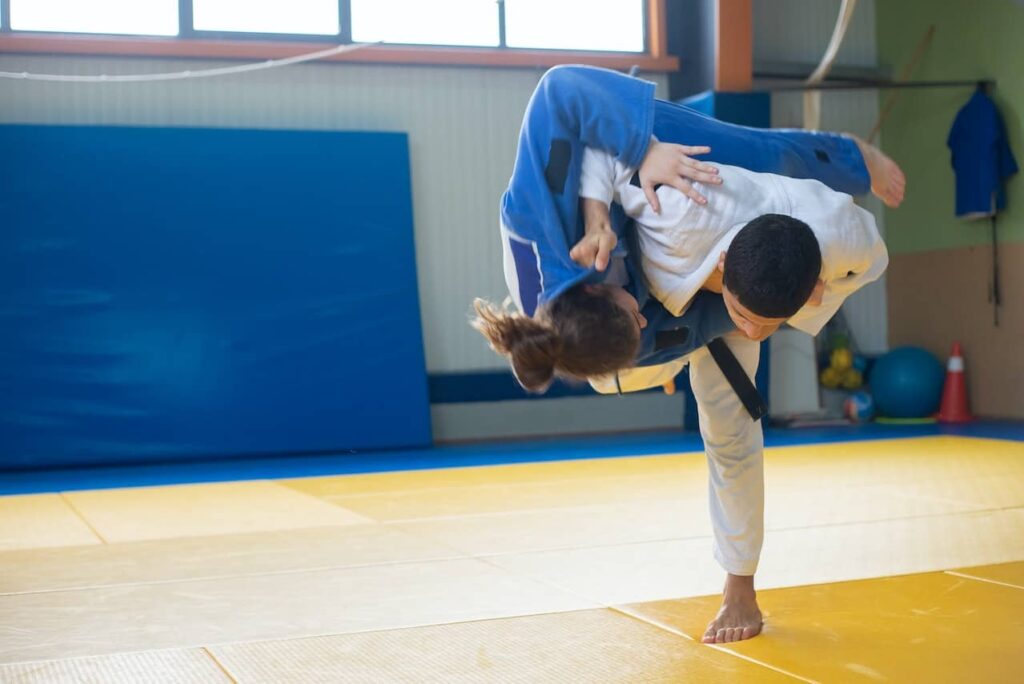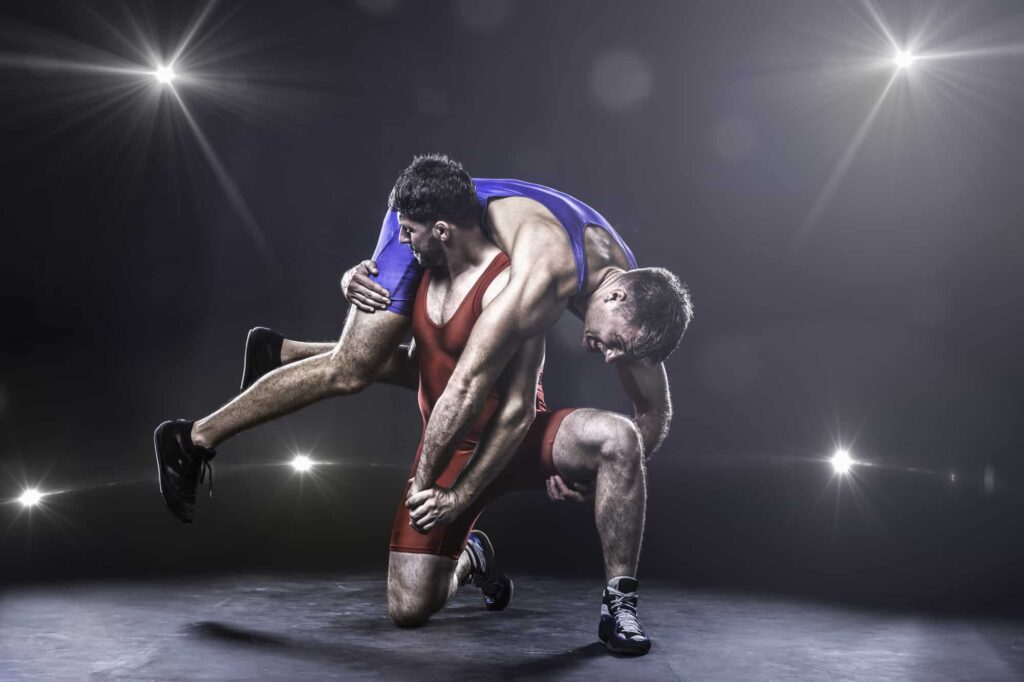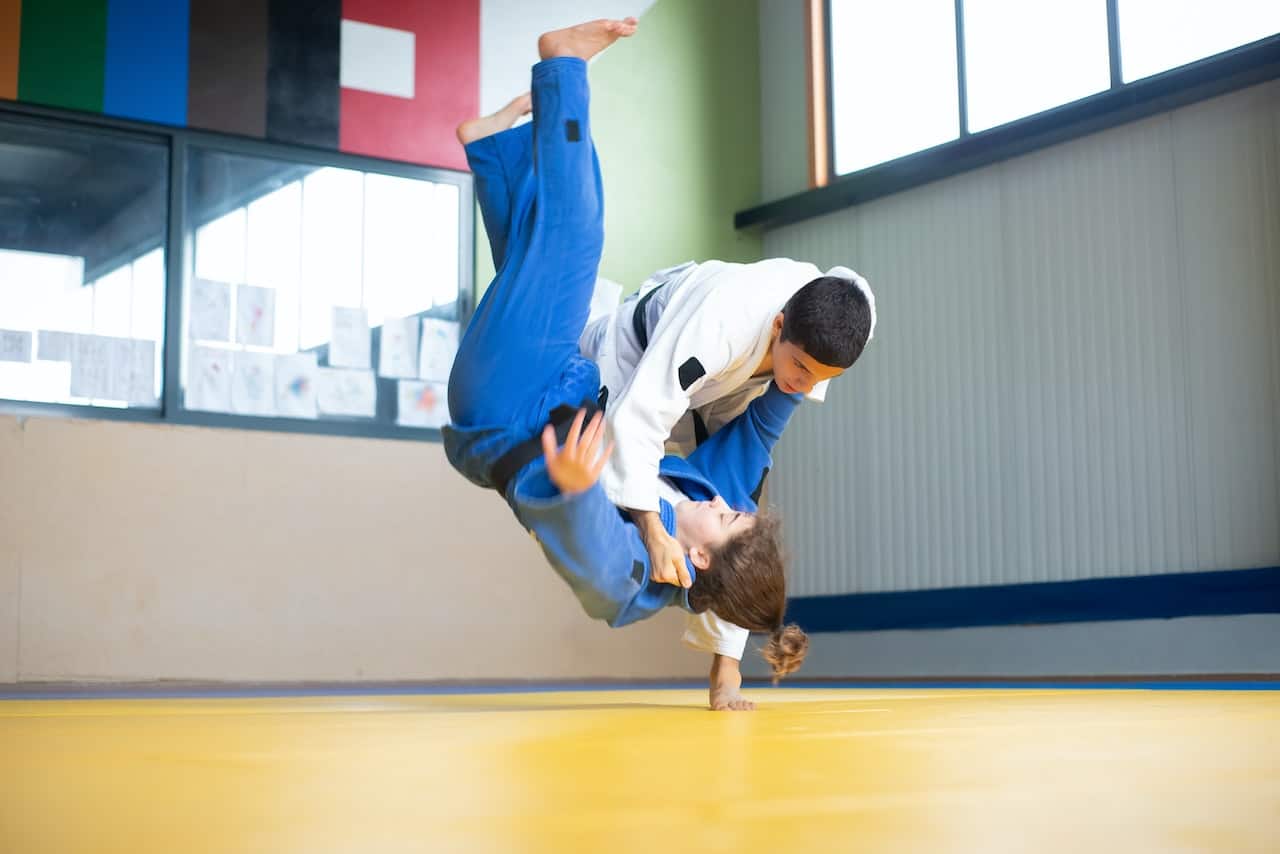Are throws allowed in BJJ competition? And are throws taught as part of the BJJ learning curriculum across BJJ schools and academies?
The truth is, BJJ came from Judo so throws are definitely allowed in BJJ competition and are included as part of the training in pretty much all BJJ schools.
Also, BJJ competition rules allows for a wider variety and even more throws than Judo competition!
But there are important reasons why BJJ does not emphasise throws as much as Judo especially in today’s modern competitive environment of BJJ and submissions grappling.

And in this post we will look at why throws are not a major part of BJJ Schools teaching curriculums and why.
As well as why BJJ has more throws available to use in competition than Judo but most BJJ practitioners choose not to make use of the wide variety of effective throws available to them.
BJJ Rules Allow More Throws than Judo
Not only are throws allowed in BJJ, but BJJ actually allows more throws in competition than Judo.
Despite the fact that BJJ or earlier on as it was known as – Gracie Jiu Jitsu, actually came from Kodokan Judo, quite a number of techniques that were part of the original Kodokan Judo are not allowed in Judo competition.
However most are permitted to be used in BJJ competition.
And these include a number of throws.
This is especially so after in 1013 the International Judo Federation (IJF) banned all leg grab techniques. Prior to the 2013 ban, leg grab techniques were quite a major part of Judo competition.
Today, however, in BJJ leg grab techniques are allowed in competition (they are just not emphasised much in BJJ schools training and we discuss why this is so further on in this post).
Banned in Judo – Allowed in BJJ
Below are highly effective Judo/BJJ throws that have been banned in Judo competition but are still allow in BJJ competition.
Kata guruma – Firemans carry
Kata Guruma is a Judo throw that translates to “Shoulder Wheel” in English.
It is classified as a sacrifice technique (sutemi-waza) because the person executing the throw sacrifices their standing position to bring their opponent to the ground.

Morote gari – Double leg takedown
Morote Gari is a Judo technique that translates to “Double Leg Reap” in English. It is classified as a hand technique (te-waza) and is one of the many throwing techniques used in Judo.
Kuchiki taoshi – single leg
Kuchiki Taoshi is a Judo technique that translates to “Single Leg Takedown” in English. It is classified as a hand technique (te-waza) and is used to take down an opponent by targeting one of their legs.
Kibisu gaeshi – Ankle pick
Takedowns in BJJ – Nah Let’s Pull Guard!
While BJJ does not use throws as much as in Judo where obviously throwing is the main aim, BJJ practitioners do at least have a few throws in their techniques arsenal and the most common being
- single-leg and double-leg takedowns
- hip throws like o goshi
- foot sweeps (e.g., Deashi Barai, Ko Uchi Gari)
- reaps like o soto gari
But in most cases it seems in BJJ competitions these days pulling guard is a far more favoured technique over executing takedowns and throws.
But why is this?
There are a number of reasons why takedowns and throws are not as prevalent in BJJ competition in comparison to pulling guard.
Scoring Opportunities
In some BJJ tournaments, the scoring system prioritizes ground positions and submission attempts over takedowns and throws.
For instance, securing a dominant position like mount or back control, or attempting submissions, can score more points than a takedown.
This scoring bias might discourage some competitors from actively pursuing takedowns.

Takedowns and Throws are Hard!
Learning to throw or take a resisting opponent to the ground is not easy – in fact it is very difficult.
Just ask any Judo practitioner how hard it is to execute a throw.
In comparison pulling guard and getting straight to the ground is a far easier technique and tactic to learn, drill, practice and actually land effectively in competition.
Energy Conservartion
Executing powerful takedowns can be physically demanding and may drain energy that could be conserved for the ground game, where the majority of BJJ techniques are applied.

Trying to manipulate your opponent and grip fight is physically draining and a lot of BJJ practitioners would prefer to get the fight to the ground quickly by pulling guard.
Risk and Strategy
Some BJJ practitioners may choose to avoid throws in competition due to the risk involved in executing them, as they could end up in an unfavorable position if the throw is not successful.
Instead, they may prefer to use other techniques, like guard pulls or takedowns, to initiate the ground game where they feel more comfortable.
Most Commonly Used Throws in BJJ
Here are some of the most popular throws and takedowns in BJJ competition:
- Osoto Gari: Osoto Gari is a common throwing technique originating from judo. It involves using a sweeping motion to reap the opponent’s leg while off-balancing them backward. It’s effective when the opponent is stepping forward with one leg.
- Kouchi Gari: Another judo throw, Kouchi Gari, involves a reaping action to take the opponent off-balance by attacking their leg from the inside.
- Ouchi Gari: This is a leg reap similar to Osoto Gari, but the attacker reaps the opponent’s leg from the inside, causing them to fall backward.
- Seoi Nage: Seoi Nage is a classic judo shoulder throw where the practitioner pulls their opponent over their shoulder and onto their back. It can be modified for gi and no-gi BJJ.
- Single Leg Takedown: The single leg takedown is a wrestling-style technique where the attacker shoots in on one of the opponent’s legs, lifts it, and takes them down to the ground.
- Double Leg Takedown: Similar to the single leg takedown, the double leg takedown involves shooting in on both of the opponent’s legs and lifting them off the ground to secure the takedown.
- Ankle Pick: The ankle pick is a low-level takedown where the practitioner grabs the opponent’s ankle and pulls it out from under them to take them down.
- Foot Sweep (Deashi Harai): Deashi Harai is a judo technique that involves using a sweeping motion to take the opponent’s foot out from under them, causing them to fall backward.
- Hip Throw (Uki Goshi): Uki Goshi is a hip throw commonly seen in judo. The practitioner uses their hip to lift and throw the opponent over their body.
- Tomoe Nage: Tomoe Nage is a sacrifice throw where the practitioner falls backward while hooking the opponent’s leg and flipping them over.
These are just a few examples of popular throws and takedowns used in BJJ competitions.
BJJ practitioners often adapt techniques from judo, wrestling, and other grappling arts to fit their game and style.
The effectiveness of a throw or takedown in competition also depends on the practitioner’s timing, setup, and ability to read their opponent’s movements.
Final thoughts
To summarise, yes throws are allowed and used in BJJ.
As BJJ is based on Kodokan Judo that is the origin of BJJ and Gracie Jiu Jitsu, throws and takedowns are a major part of Judo as BJJ subsequently.
However as BJJ has evolved over the decades and BJJ competition has become more and more popular, practitioners have become more specialised in areas such as half guard, 50/50 guard and other ground fighting areas.
As such takedowns and throws have become less and less necessary to achieve success in BJJ compeition.
So while BJJ does allow throws, in today’s modern competition environment, pulling guard is a more favourable strategy for various reasons discussed above in this article.



